| Copyright, Kellscraft Studio 1999-2005 (Return to Web Text-ures) |
Click
Here to return to |
| Copyright, Kellscraft Studio 1999-2005 (Return to Web Text-ures) |
Click
Here to return to |
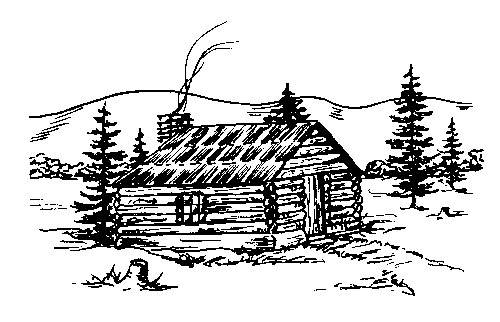
Sister
Mary
Felicitas, R.S.M.
Republished
by
Kellscraft Studio
2005
Originally
printed by the
Museum of Pok-O-Moonshine
I
was born in 1880
so have lived through the “good old days” which are
my memories now. A
friend
said to me a few years ago, “Why don’t you record
these things. Your
generation
will soon be gone and there will be no one who remembers,” so
that is
how my
memories came into existence.
Leila
M. Wells
Essex,
New York
October,
1969

TRAVELLING
One
lovely
afternoon in February, I enjoyed a fifty mile trip to Lake Placid to
visit my
granddaughter. It took about an hour in one of the new automobiles.
As
I journeyed I
thought of the difference in travel from my grandmothers’ day
to the
present
time.
It
would have
taken my grandparents more days for the trip than the hours which it
took me.
When
grandmother
went to town or to visit a neighbor she went on a farm wagon drawn by a
yoke of
oxen. There was a long board placed on the front and rear axles, a
chain was
fastened to the axles for her feet to rest upon and a rope was strung
from
stakes for her back and for her to hang onto so she wouldn’t
lose her
balance
and fall. Sometimes they used the wagon box with a chair in it or it
had straw
for her to sit on. This was used if they were “going to the
store.”
Grandmother
didn’t go shopping every week like her granddaughter does.
How
proud the
family was when a horse was brought home hitched to a
“democrat” wagon.
This
wagon had no springs and a short reach between the axles so was not
much easier
riding than the farm wagon but the horse was faster than the oxen so it
shortened the time on the road.
After
the
“democrat” came the “buck
board.” So called because the “reach” was
longer and
gave some spring to the seat, especially if the occupants were heavy
people
like both my grandparents.
Later
came the
carriage. This was quite elegant as it had a “top”
that would fold down
and
especially if it had hard rubber tires. Then there was the buggy. I
don’t know
why it was so called. Then the family wagon with two or three seats and
a
canopy top called a surrey.
I
mustn’t forget
to mention the stagecoach or “tally ho” which was
enclosed with doors
on either
side with space and seats on top for six or eight passengers or for
baggage.
It
was wonderful
for us children to watch the “tally ho” go by with
the horses on the
run and
the horn blowing. This was the way they entered the main Street of Lake
Placid
in the 1880’s. Sometimes there were four horses hitched to
the
stagecoach.
It
has been most
interesting to watch the improvements in the automobile from the
beginning of
the century to the present day.
The
change in our
highways has been as great as the change from the ox wagon to the
present
automobile.
When
my father was
a boy his father was commissioned to survey and build a road past the
Cascade
Lakes, which would shorten the route between Keene and Lake Placid.
As
a child I
remember riding over that road when it was so narrow that teams
couldn’t pass
each other only at the “turning put” places. Now it
is a two lane
highway.
Most
of the roads
now are hard surface. The owners of the first automobiles had to leave
them in
the barn after the first snow fall and until the mud was dried up in
the
spring. There were no snow plows then nor sanders.
After
heavy snow
falls, the farmers would hitch their teams to their heavy sleighs and
fasten a
board to one side of the back sled and plow the roads themselves.
Sometimes if
the roads were badly drifted they’d take down a portion of
the fence
and drive
through the fields around the drifted portion of the road. Those were
“the good
old days.”
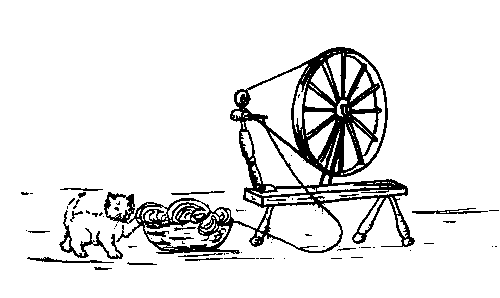
WOOL
(By
Mrs. Thomas
J.
Wells) Leila M. Wells
Did
you ever hear
someone say, “You must be wool gathering?”
Everyone
knows
that wool comes from sheep, and raising and caring for sheep is the
oldest
occupation of man. Cloth made from wool is the oldest fabric.
The
sheep of today
is so different from the sheep of Bible time as to be almost a
different animal
except that its coat is still wool. Even in the years of my remembering
there
have been improvements in the size of sheep and in the grade of wool.
Shepherds
watched
their flocks by night lest even one little lamb should go astray.
The
sheep’s wool
grows during most of the year and gets long and thick during the cold
weather,
but when it gets warm the wool loosens from the skin and is easily
pulled loose
and comes away, otherwise the poor animal would be very uncomfortable
as the
summer gets warmer.
Now-a-days
the
wool is clipped off with electric shears, rolled into bundles and sold
to
dealers. Years and years ago the early shepherds had no shears with
which to
clip their flocks so each sheep was plucked or picked as its wool
loosened.
Those who didn’t own sheep used to go around the pastures
gathering the
wool
from the bushes where it had been pulled out as the sheep went through,
wandering from one place to another and thus came the expression
“wool
gathering.”
As
a child I
remember when grandfather “sheared the sheep.” It
was a warm day the
later part
of May. Each sheep was caught and held while a man with a pair of
“sheep
shears” (similar to our present day grass shears) started in
on the
front legs
and cut the wool off close to the skin all over the sheep and how bare
and
funny it looked when let run. Often the poor little lambs
didn’t know
their own
mothers.
Grandfather
sold
most of the wool but always kept several fleeces for family use. He
always kept
at least one black sheep whose fleece made gray yarn that
didn’t have
to be dyed
and Grandmother used that for socks for her men folks.
After
the
“shearing” the women took care of the wool that
wasn’t sold. First it
had to be
washed, then dried, and I’ve spent hours helping
“pick” it as it was
always
matted together after the washing. Grandfather then took it to the
“carding”
mill where it was made into “rolls” for spinning. Sometimes
Grandmother carded it herself into ‘batts” to be
used
as filler for new quilts.
Her
spinning wheel
was different from any other I ever saw as she could sit down and the
“head”
swung out and back instead of being stationary like the other spinning
wheels
where the spinner had to walk up and back.
The
first yarn was
spun very fine and generally two strands were twisted together for
knitting
socks and stockings and mittens. Only one strand was used in weaving
cloth.
“Great-grandma” had a loom in her kitchen and I
remember seeing her
weave
material for Grandfather’s shirts. It was even check, yellow
(“copperas”) and
blue. Later the loom was used for weaving rag carpets and rugs.
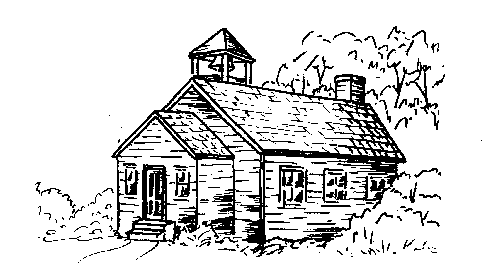
SCHOOL DAYS
A
big yellow
school bus has just gone by my house having left about a dozen boys and
girls
on the corner near by. Not one of them will walk but a short distance.
School
is so
different from my school days. I wonder if the children ever think how
school
might have been in their grandparents’ days.
When
I began going
to school back in the 1880’s I had to walk at least one and a
half
miles to the
“old red school house” where all grades (grades
were unknown then) were
taught
and as I was one of the little ones, I was left mostly to myself. No
“busy
work” or anything interesting to do.
The
teacher
believed in the “hickory stick” method and maybe he
had to as some of
the
pupils were as tall as he. I was as afraid of him as I was of the
travelling
bears that came to our village every summer.
After
a year or
two in that school, a teacher named Mrs. Mary Stickney opened a
“select” school
in the top story of a boat house and the parents paid a set price for
each child.
She
was a good
teacher and I began to like school and to learn. Her only fault, as I
decided
later, was that she had favorites — her two daughters and my
younger
sister.
She
was a
beautiful penman and we had regular writing lessons in home-made
writing books
with copies written by her. “Every line and every letter, try
to write
a little
better” was one.
My
next school was
a new one room one built across the road from my home so I
didn’t have
to walk
very far. It was taught by a William Barker who later became a Baptist
minister
and was stationed at Elizabethtown for several years.
My
schools until I
became a teacher, were mostly one room district ones and even as a
teacher I
had the one room schools and taught all the grades.
Grades
were
originated after I began teaching. Before that a pupil could be doing
5th grade
arithmetic and 8th grade reading and history. Social studies was
unheard of.
One
of my teachers
was an old man who had once been a school superintendent and his
hobbies were
arithmetic and “grammar” (English). If he finished
the regular schedule
a
little before four o’clock (the usual closing time) he would
say,
“Let’s add a
little bit,” and put a column of figures on the blackboard.
Diagramming
was the
next favorite and I’ve seen sentences from our 5th grade
reader that
covered
half the blackboard space. Diagramming is a lost art now.
At
recess and noon
we played games. “One old Cat” was a game for
three, “two old cats”
took four.
This was a ball game. The smaller children played “Drop the
handkerchief” or
“Ring around the rosie.”
How
would today’s
children like to be in school from 9 until 4 with no electric lights or
any of
today’s “necessities” and have to walk to
school?
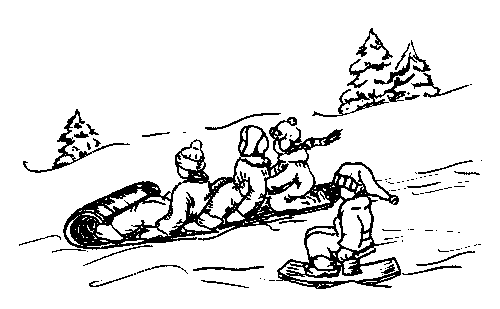
WINTER
SPORTS
“Jolly
old winter
has pleasures for me.” Each season has its special joys and
pleasures.
Just as
I could hardly wait in the spring for a certain apple tree to blossom,
so I
could go barefoot, so it seemed that snow and ice would never come so
that I
could skate and slide down hill.
I
loved to slide
and I’ve slid on about everything except skiis, which were
not in
existence in
my sliding days. A barrel stave was the nearest to a ski in my
childhood.
Tho
“babysitters”
were unknown when I was small, I remember several times when a relative
was
available that my parents went tobogganning with other young people. We
were
living in Lake Placid then and the sliding parties were held on
Steven’s Hill.
From the top of the hill the toboggans would go nearly to the opposite
side of
Mirror Lake.
The
summer before
I was seven, my sister and I saved our pennies and when winter came we
bought a
sled. It had a little girl painted on the blue top so we called it
Marjorie
Daw. We were still sliding on it years later whenever there was a crust
and we
were home from our schools, over the weekends. We’d get up
early in the
morning
and go out for about an hour of fun. Each took a sled but I usually
took the
toboggan. Once in a while one of my sisters would feel brave enough to
take a
slide with me. Our “bobs” were two sleds held
together by a long plank.
Sometimes the sleds were owned by two different boys and the plank was
removable. It was a long way from the “bobs” used
on the Olympic runs,
as ours
had no brakes and no steering gear, except the rope and the
steerer’s
feet. The
ride down the hill was fun but the hike back with the heavy bobs was
not so
funny. Each slider was supposed to lend a hand during the return.
It’s
too bad that
cameras were so rare in those days as pictures of our loaded bobs would
be very
interesting now, as we didn’t have the sports clothes that
are the
“must” of
today. There were no rails for our feet so each had to hold the feet of
the one
behind him on the plank except for the steerer, so no one really wanted
to be
second on the plank as he was responsible for his own feet as well as
those of
the one behind him.
The
nearest thing
to the present “Flying Saucer” was an old wooden
butter bowl. These
butter
bowls are not available now as what few are still around in some
antique shop
and priced sky-high. I never had slid in a Flying Saucer but in an old
bowl one
goes round and round until the bottom of the hill is reached and then
one has
to sit for a while until his head clears. A tin pan was sometimes used
as a
substitute for the bowl. An old shovel of any kind gives one a thrill.
After
the toboggan I think I enjoyed the “skipper” next
best. What’s a
skipper? It
was made from a barrel stave, a block of wood about a foot high and a
small
piece of board for the seat. One needed to have perfect balance to make
a
successful descent, but it was thrilling, at least I found it so.
We
used to have
skipper races to see whose skipper went the fastest, as nearly everyone
had one
and some boys had several. Sometimes two staves were fastened together
and some
of the skippers were fastened together. Sometimes two staves were
fastened
together and some of the skippers were made of four staves, two on top
and two
on the bottom and these didn’t need the block of wood and the
board.
These were
used more like a toboggan, but only one could slide on it at a time.
Our
dog, Dixie,
loved to go sliding with us, but we didn’t enjoy her company
so much,
as she’d
grab us by the cap or sleeve and drag us off the sled, as she seemed to
fear we
would get hurt.
Father
thought we
shouldn’t learn to skate until we were ten years old but I
cheated. My
brother
was older than I so when he was tired of skating, he’d let me
take his
skates.
There was a small depression in our lawn and each winter we lugged
water to
fill it and make a place to skate. Here we learned to avoid disaster by
all of
us going in the same direction. As we entered our teens we were allowed
to
attend skating parties on the village mill pond. Generally a bonfire
was built
on the shore and when tired of skating, we’d gather round it
and sing
the
popular songs.
CHARCOAL
Charcoal!
What
thoughts come to your mind at the mention of this word? Delicious
steaks and
barbecues? Neat little blocks in a paper sack bought at the store?
To
me the word
brings memories of my grandfather and “the boys”
(my two oldest uncles)
and my
father, all of them grimmy and smelling strongly of smoke.
It
wasn’t until I
was in my early twenties that I learned more about it and what
“burning
charcoal” really meant. I was teaching in a country district
where that
was one
of the sources of income and was invited to spend a Saturday in the
woods
watching the process.
There
were no
chain saws then so the cutting of the trees was done mostly with an ax
and a
bucksaw, or a cross-cut saw was used to cut the trees into four-foot
lengths.
When
the trees had
been made ready, the men started “making the pit.”
I never could learn
why it
was called a pit for the pieces were stood on end, four or five at
first and
then a row of sticks around them and more rows around until the base
was about
fifteen or eighteen feet across. Then another tier was built in the
same way on
top of the first. When this was finished it was covered with evergreen
branches
and then about a foot of dirt was packed on until the whole looked like
an
Eskimo’s igloo. A small opening was left in the top for the
smoke to
come out
and small openings at different places at the bottom where the fire was
started. This had to be watched constantly so that it would burn slowly
and not
go up in a glorious bonfire. If a blaze started, more dirt was put on.
It took
several days of slow burning and Constant watching for the wood to
reach the
right stage for “drawing.” Drawing consisted of
first closing all
drafts and
the slow dying of the fire, then the uncovering and raking which had to
be done
slowly so as not to start the fire in case a spark was left.
Finally
the
charcoal was bagged in burlap bags and drawn in farm-wagons to market.
At
that time
charcoal was used in summer hotels and blacksmiths’ forges
but in my
first
memories it was used in iron smelters and forges.
Grandfather’s
charcoal was
drawn by ox team to the iron works at Black Brook. Father used to time
our
visits to “Grandpa’s” so as to be there
to help him when he needed more
than
“the boys,” which was generally during the burning
when someone had to
watch
day and night.
Charcoal-burning
used the timber that now goes into pulp wood. The tops and limbs too
small for
charcoal sticks are used for fire wood. The peculiar odor of the smoke
is
always associated with my grandfather’s home.
CORN
“When
the swallows
come to the barns it’s time to plant the corn.”
Planting
corn has
changed since I was a little girl on the farm, like all farm operations.
There
were no
riding implements in those days and the farmer walked miles each day as
he
guided the plow and then “dragged” the field to
prepare it for planting.
When
the field was
considered ready for planting it was cross-marked by two men who
carried a long
pole with three or four chains attached, three feet apart, dragging so
as to
mark the place for the hills. Some farmers had an idea that the marker
could be
drawn by a horse so one man could do the marking. This marking was
necessary as
an aid to the cultivation of the growing corn.
After
the field
was marked both ways, it was ready for the planting which was done on
Saturday
if possible so the children could help — one child to each
adult.
The
man would dig
a hole with a hoe and the child would drop the kernels into it and then
dirt
was hoed over it and generally given a pat with the hoe or was stepped
on to
firm the soil over the corn.
Five
kernels were
the usual number put into each hill.
|
“One
for the
cut-worm, One for the crow, One for the woodchuck And two to grow.” |
And
as soon as a child
could count to five he was considered old enough to help. He carried
the corn
in a small pail. If no child were available, the man had a canvas pouch
tied
around his waist and counted out the kernels with his left hand while
using the
hoe with his right.
Before
a horse
drawn cultivator was invented, the weeds were cut down with a hoe,
several
times through the growing season.
When
the corn had
ripened it was cut by hand with a tool called a “corn
cutter,” laid in
bundles
and tied either with withes of twisted grass or binder’s
twine. Then
set up
several bundles together in “stooks.”
When
twine was
used it was cut into the right length for tying, and carried, generally
by
being drawn through the suspenders (an unknown article today when belts
are the
main support of a man’s trousers) of the binder.
The
stooks were
left in the fields for several weeks to dry out. When dried they were
brought
into the barn for husking out the ears of corn. Sometimes if the
weather was
good the husking was done in the field.
A
“huskingpin” was
used for the easier opening of the husks. This was generally a pencil
shaped
piece of wood a little less than an inch in diameter and six inches in
length
with a leather loop in the middle which slipped over the middle finger
to hold
it in place whenever the hand was opened.
Often
a “husking
bee” was held if the farmer had a large barn and lots of corn
to be
husked.
This was an occasion for a “frolic” and the girls
joined in the work
and the
fun and sometimes there was competitions to see which couple could husk
the
most corn.
A
red ear earned a
kiss for the husker.
New
cider and
doughnuts were the refreshments.
The
Indians grew
corn (maise) before the Englishmen came to America and taught them how
to grow
and use it.
Hominy,
grits,
samp, and corn meal are all corn products.
“Hulled”
corn used
to be a great treat. Lye obtained from wood ashes used for soaking the
corn
until the hull and eye could be rubbed off easily and then the corn was
washed
in several waters until no hulls and eyes remained. This corn was
similar to
today’s hominy or samp.
My
mother used to
make a large amount of this each winter and kept it frozen in a crock
in an
outside room, bringing in whatever she thought was needed for a meal.
Sometimes
it was served with milk and sugar as a cereal. Popcorn has always been
as
popular as it is now although we never had it in such variety.
Nearly
every home
had a “corn popper.” This was a rectangular wire
box with a tin lid on
a long
wooden handle. If not one of these as substitute a
“Spider” or kettle
was used.
When a spider or kettle was used it was possible to put butter and salt
into
the corn as it popped.
A
small family
sized popper was invented after electricity became used more generally.
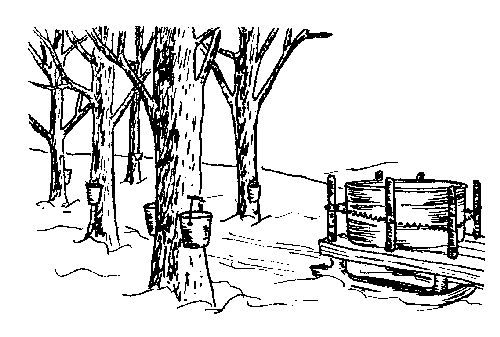
SUGARING
(By
Mrs. Thomas
J.
Wells) Leila M. Wells
Did
you ever eat
maple sugar, maple fudge or syrup? And did you ever wonder where such
delicious
flavor was found? It’s truly American.
The
Indians were
the discoverers of this deliciousness and taught it to the early
settlers of
New England and New York. How did they discover it? Thereby hangs a
tale. The
story goes, so I’ve been told, that some Indians were on a
hunting trip
and cut
a maple tree for their camp fire and noticed the drip of what they
thought was
water from a cut in the tree, and, as water wasn’t too
plentiful, they
placed
one of their dishes under it and caught quite a little. Some brave
tasted it
and found how sweet it was and when they used some of it for cooking
they
discovered that it became sweeter so when they returned home they tried
boiling
it and discovered syrup. I don’t know if they or the Pilgrims
were the
real
discoverers of the final process that produced the sugar but it
probably was
accidental also. Perhaps some housewife neglected to take the syrup off
the
fire at the right time and it “sugared off” as the
expression goes.
There
have been
many improvements in the process of maple sugar making even since my
earliest
memories of it. At first the sap was boiled in a large brass or iron
kettle out
of doors and was “finished off” in a smaller one in
the house as syrup
or
sugar.
One
of my earliest
memories is of the time my mother, my brother and I went into the sugar
bush to
spend the night. At that time sugaring had advanced to the stage where
it was
no longer just a family means of obtaining sweetening for pies and
cakes and
apple sauce.
“Sugaring
off” was
an occasion for a party. The boiled-down syrup was poured on the snow
to cool
and the “wax” was the most delicious thing ever
tasted. That was the
way the
maker knew when the right stage for sugar was reached. “Soft
sugar” was
poured
into tubs to be used later. “Hard sugar” was put
into tins or molds and
sold to
the “city people” during the summer.
My
father had a
large “sugar orchard,” as it’s now
called, several miles from home so
he had a
“shanty” where he boiled the sap in a large pan
instead of a kettle and
had a
bunk where he could sleep when he didn’t have to feed the
fire or add
more sap
to the pan.
Sugaring
generally
started in March and continued for five or six weeks or until the leaf
buds
started to grow. During the early part of March preparations started by
getting
the buckets and spouts ready. Now-a-days these are purchased but at
that time
they were hand made. The spouts were made from sumac branches about an
inch in
diameter and cut six inches long. One end was whittled down to fit a
three-quarter inch hole. About half way of the stick, a sawing was made
to the
center of the stick and that half was split off. A wire was used to
push the
pith out. When the spout was driven into a hole in the tree the sap
would come
through and drop into a bucket placed underneath.
The
buckets were
hand-made of wooden staves. I’ve watched my father make them,
and years
later I
visited the same sugar bush and saw the buckets and sap yoke that he
had made.
Gathering
sap was
different then from now, when it is done with a large tank on a sled
drawn by
horses. Then it was done by men emptying the smaller buckets into two
larger
ones which were carried on a yoke across the shoulders. When the large
buckets
were full, they were carried to the shanty where they were emptied into
storage
barrels and the man went back for more. Sometimes he had to carry his
load
quite a distance, so he walked miles through the snow and slush as sap
runs
only when the temperature is above freezing.
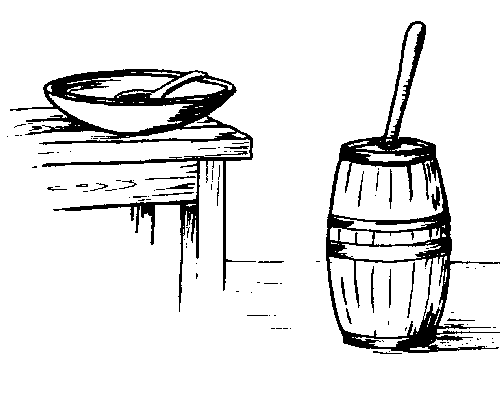
BUTTER
Leila
M. Wells
When
you put
butter on your bread or toast, do you ever think what it is, where it
comes
from and how it is made?
Butter
comes from
cream, cream comes from
milk and milk comes from a cow. A farmer cares for the cow, feeds her
and milks
her but now-a-day, he does not make the butter as in the days long past.
Years
ago nearly
every family owned a cow even though they had very little land. The cow
was
pastured generally in a community lot and either milked at the pasture
bars or
brought to the home barn.
The
milk was
strained through “cheese cloth” into shallow pans
and set on shelves,
either in
the pantry or cellar for the cream to rise. After about twenty-four or
thirty-six hours the cream was skimmed off with a tin skimmer. This was
an
instrument with holes in it so the milk would run through as the cream
would be
too thick to go through.
When
enough cream
had been accumulated it was put into an earthen jar called a
“churn”.
The cover
had a hole in it so the “dash” handle could come
through and be worked
up and
down, keeping the cream in motion until the butter formed in small
particles.
These particles were skimmed out into a butter bowl (a large wooden
bowl) and
water added to wash out whatever milk was left in. Generally two
different
waters were used and a ladle was used to agitate the butter particles
and wash
out the milk. Then the salt was added, about an ounce of salt to a
pound of
butter, and thoroughly worked in so that the butter wouldn’t
be
streaked.
Then
it was made
into balls for the table or packed in earthen jars or wooden tubs for
market.
A
childhood treat
was when my grandmother would put a pan of sour or
“labbard” milk in
front of
me and sprinkle it with brown sugar. “Delicious” in
my estimation.
Making
butter was
our chief source of income when we were first married.
We
had a small
“separator” so we didn’t use pans and we
had one of the new churns a
barrel set
in a frame and turned end to end by a hand crank.
We
had regular
customers and packed the butter in earthen jars, holding from five to
ten
pounds and if we received over twenty-five cents a pound we thought it
wonderful.
Butter
now comes
from large factories, wrapped in waxed paper in one pound packages and
tastes
like money.
In
olden times if
the butter was slow in breaking, a fire poker was heated red hot and
thrust
into the churn to “burn the intch.” This raised the
temperature of the
cream
which was just what was needed. Cold cream was slow to turn into butter.
In
olden times
when the butter in winter didn’t have the bright color of
June, the
butter-maker used the juice of grated carrots for coloring. Later
a coloring was obtainable at the
village store.
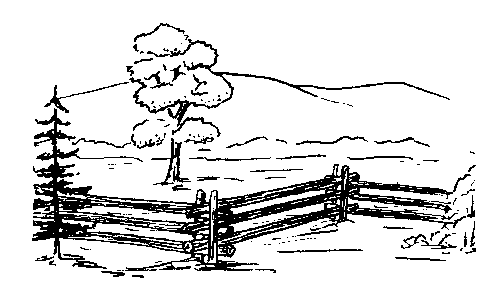
FENCES
“Don’t
fence me
in” are the words in an old song, so fences have existed for
ages and
there are
many kinds for many uses.
The
early settlers
used what was available such as stumps, rails and stones.
The
stump fences
that remain today are really quite unique and pretty.
That
was one way
that the early pioneers could make use of what was on hand and what
today is
destroyed was then used. They served two purposes, cleared the land and
fenced
it at the same time.
As
so many of the
farms were stony, the stone fences or walls as they were called, also
served
these two purposes. Many of them have disappeared now as they have been
used
for house and barn foundations and as sub-bases for many of the new
roads.
Rail
fences came
next and they were of two kinds, those laid zig-zag and those laid
straight
with their ends through holes in a larger rail driven into the ground.
These
fences took up less room than the zig-zag ones and it was easier to
keep the
fence row clean of briars and brush.
Then
came the
barbed wire fences and later still the woven wire ones.
Ornamental
fences
were used in villages and around lawns and gardens.
Some
of the fancy
iron work fences are still found and the white picket fences are being
built
now-a-days more as a decoration than for a practical use.
Most
farmers are
doing away with the old types of fences and are using the one strand of
wire
which carries electricity and one contact with the fence is sufficient
to teach
the animals to avoid it.
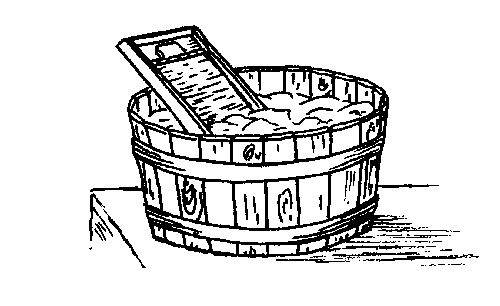
WASHING
I’ve
just returned
home from the laundromat and I couldn’t help thinking how it
would seem
to do
my laundry the way my grandmother did hers or even as my mother did.
I
remember
watching my grandmother do her washing one summer day when I was seven
or eight
years old.
First
my uncle
filled a large iron kettle from the brook near the “wash
place” which
was a
little way from the back of the house, near the brook and under some
trees.
The
kettle was set
on three or four large stones and a fire was built under it. When the
water was
hot, some of it was put into a large wooden “wash
tub” which set on a
bench
near by. Into this Grandma put the sheets and pillow slips after adding
a
generous amount of soft soap and then she put in the “rub
board” and
proceeded
to give each article a good rubbing.
After
each article
was rubbed it was dropped into the big kettle and boiled.
After
each article
had been rubbed and boiled it was rinsed in several waters from the
brook and
spread on the grass to dry. The colored clothing was not boiled but was
rubbed
extra and spread on the bushes to dry.
Mother’s
washings
were similar only her wash water was heated on the kitchen stove in a
“boiler.”
This was a tin or copper, oblong vessel with a cover And she had a
“pound
barrel” and “pounder.” The barrel was
hard wood and the clothes were
pounded
with an article similar to the old dasher of a churn until someone
invented a
pounder with a spring. Some “pounders” were blocks
of wood about six
inches
across and ten inches high, fastened to an old broom stick.
The
first washing
machines were open tubs with a corrugated lining and a semi-circle rub
board
and was hand operated. Only a few articles could be washed at a time in
them.
The closed tubs came soon after and were still hand operated. Then
someone
invented one that could be operated by a dog or goat in a tread mill
attached
to the wheel of the machine by a leather band.
Grandma
wrung her
clothes by hand but Mother had a wringer which was a great help, both
in time
and strain on the clothes.
There
used to be
considerable competition to see which woman would get her clothes on
the line
first on Monday morning. And if you didn’t wash on Monday you
were
considered a
poor housekeeper. One woman remarked that she couldn’t wash
or iron and
be a
Christian all in one day.
The
ironing was
done with flat-irons heated on the kitchen stove and usually consisted
of a set
of three — two heated while one was used. A collection of old
flat
irons, as
they were called, makes an interesting exhibit at any antique show.
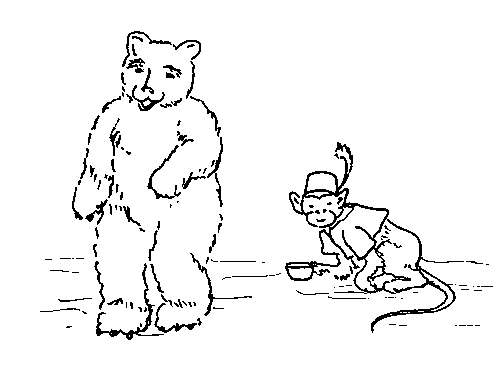
BEARS
AND MONKEYS
When
I was a child
the coming of the bear was looked forward to with both fear and
anticipation.
When
the word
spread that the bear was coming I generally ran for the house but
curiosity
soon overcame my fear and I joined the other children on the side of
the road.
Generally
there
were two men, dirty and unkept, with the bear which was black or brown
(cinnamon) lead by a chain fastened to the collar. One man lead the
bear and
the other man followed with a prod with a sharp point.
When
a crowd had
gathered the bear was made to dance while one of the men sang
“Tarry-ta-roon,
ta roon ta ray” over and over.
Then
the men would
shout “Twenty-five cents to see the bear climb the telephone
pole.”
Someone was
always willing to part with the hard earned quarter.
The
men and bear
usually spent the night in some farmer’s barn.
The
last
travelling bear that I remember seeing appeared one morning just as
breakfast
was being served at the now vanished Hunter’s Home in New
Russia. Not
one of
the boarders or help missed the sight. This was the summer of 1906.
Another
event
which occurred each summer but was looked for with great anticipation
was the
coming of the organ grinder hand organ man and his little monkey, Jocko.
Jocko
wore a
little red jacket and did so many amusing things that the organ grinder
usually
resembled “The Pied Piper of Hamlin,” as he went
along the street.
The
children
nearly emptied their “piggy banks” to put money
into Jocko’s little tin
cup.
Whenever he received a few pennies he’d climb onto the
man’s shoulder
and empty
them into the man’s hand.
The
organ was an
oblong box which the man carried on a strap around his neck. It had a
crank on
the right side which he turned to produce the music and a movable leg
which was
let down to help hold the organ while the crank was being turned. Oh!
The joys
and pleasures of childhood.